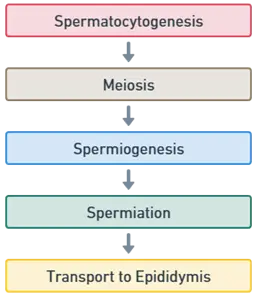- Spermatogenesis is a complex, highly organized process of sperm cell (spermatozoon) production in males.
- It occurs within the seminiferous tubules of the testes, the male reproductive organs responsible for sperm and testosterone production.
- This process is critical for sexual reproduction and involves several stages, each marked by specific cellular transformations under the influence of various hormones.
Initiation and Location of Spermatogenesis
-
Initiation:
- Spermatogenesis begins at puberty and continues throughout a male’s life.
- It is regulated by hormones such as testosterone, follicle-stimulating hormone (FSH), and luteinizing hormone (LH).
-
Location:
- The process occurs within the seminiferous tubules of the testes, where germ cells (spermatogonia) develop into mature spermatozoa (sperm cells).
Advertisements
Stages of Spermatogenesis

- Spermatogenesis is divided into three main stages: Spermatocytogenesis, Meiosis, and Spermiogenesis.
Advertisements
-
Spermatocytogenesis (Proliferation Phase)
- Spermatogonia, the diploid stem cells located at the periphery of the seminiferous tubules, undergo mitotic divisions. This division results in two outcomes:
- Self-renewal to maintain the stem cell pool.
- Production of primary spermatocytes (destined to become sperm).
- Primary spermatocytes are diploid cells that move toward the lumen of the tubule, preparing for the next phase of division.
- Spermatogonia, the diploid stem cells located at the periphery of the seminiferous tubules, undergo mitotic divisions. This division results in two outcomes:
-
Meiosis (Reduction Division)
- Meiosis I: Primary spermatocytes undergo the first meiotic division to form two secondary spermatocytes, each with half the original number of chromosomes (haploid).
- Meiosis II: Secondary spermatocytes rapidly enter the second meiotic division to produce four spermatids, each haploid with a single set of chromosomes.
-
Spermiogenesis (Maturation Phase)
- Spermatids undergo extensive morphological changes to become mature spermatozoa.
- Development of the acrosome (enzyme cap that helps sperm penetrate the egg).
- Condensation of the nucleus to carry genetic material.
- Formation of the flagellum (tail) for motility.
- Shedding of excess cytoplasm to streamline the sperm’s structure.
- Spermatids undergo extensive morphological changes to become mature spermatozoa.
-
Spermiation
- The final step in spermatogenesis is spermiation, where mature spermatozoa are released into the lumen of the seminiferous tubules.
- Once released, the spermatozoa are transported to the epididymis where they undergo further maturation and are stored until ejaculation.
Hormonal Regulation in Spermatogenesis:
- Hormonal regulation is essential for the initiation and maintenance of spermatogenesis. The key hormones involved include:
Advertisements
-
Follicle-Stimulating Hormone (FSH):
- Stimulates spermatogonia proliferation and supports the nourishment of developing sperm cells via the Sertoli cells.
- Indirectly promotes spermatogenesis by inducing Sertoli cells to release factors that promote spermatocyte survival and division.
-
Luteinizing Hormone (LH):
- Acts on Leydig cells in the testes to produce testosterone, which is essential for the final maturation of sperm and the development of male secondary sexual characteristics.
-
Testosterone:
- Plays a direct role in stimulating spermatogenesis.
- It is crucial for the initiation and maintenance of spermatogenesis and the overall health of the male reproductive system.
Importance of Spermatogenesis:
- Spermatogenesis is vital for sexual reproduction, ensuring the transfer of genetic material from one generation to the next.
- It is an efficient and continuous process, with a healthy male producing millions of sperm each day.
- The process is sensitive to factors such as hormonal imbalances, environmental toxins, and lifestyle choices, all of which can impact male fertility.
Click Here to Watch the Best Pharma Videos
Advertisements
